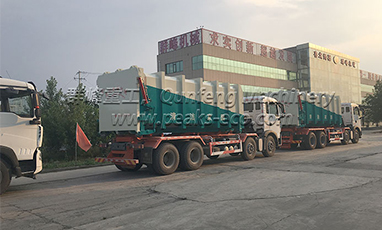Recycling sorting equipment suppliers will share with you the operation mode of the waste transfer station.
Container compression
That is, different types of garbage collection vehicles arrive at the transfer station and dump the garbage into the garbage pit. The pit is equipped with push plates to evenly push the garbage into the garbage compressor, and then enter the garbage container while pressing the compressor. When full, the garbage, special container, and semi-trailer are pulled to the garbage disposal site by the tractor. The container semi-trailer is equipped with a hydraulic push plate device. The tractor provides the power source to unload the garbage to the disposal site.
Pre-compressed packing transfer method
The garbage is compacted and packaged at the transfer station, bundled with iron wire, and finally transported to the disposal site by the transfer truck. This type of transfer station requires low water content in the garbage and can only handle bagged garbage.
Conveyor type transfer
That is to say, after various types of garbage trucks enter the station, they unload the garbage on the bottom conveyor belt at the side of the tunnel-type pit. The garbage is sent to the garbage transfer truck container by the conveyor belt and finally transported to the disposal site. The biggest disadvantage of this form is The operating cost is high, the failure rate is high, and the garbage is stored in the open air, the environmental pollution, mosquitoes, and odor problems are serious.

Underground Horizontal Waste Transfer Station System
Open top direct loading
This form is to open the top of the container directly, and the garbage collection truck directly discharges on the top. It is sometimes used in some small and medium transfer stations. Its main disadvantage is that the garbage is hardly compacted, and transportation efficiency is low. It cannot allow several collection trucks. Unloading at the same time, and the loading process is not sealed, environmental pollution, mosquitoes, and flies, odor problems are more serious.
Grab direct loading transfer method
The collection truck dumps garbage from the third floor to the second floor, and is pushed by the bulldozer to the vicinity of the steering grab, and then picked up by the steering grab and loaded into the transfer truck container. The biggest disadvantage of this form is that the second-floor space environment is extremely harsh and the efficiency is low.
Machine shredded waste transfer method
The garbage is sent to the transfer station, the garbage is crushed by machinery and then transported to the treatment site. Such a transfer station is expensive and slow to process the garbage. Except for special requirements, it is now used in a few places.